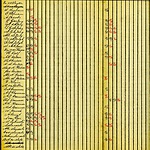The De Jongh Family
Israël de Jongh and his wife Marianne Polak settled in Leeuwarden in 1916. They lived at 7 Schoolstraat. Israël de Jongh was a merchant of baker’s ingredients. He married Marianne Polak in Wildervank in 1911. At first the couple lived in Bolsward, where three of their daughters were born: Rika (on 7 September 1912), Rachel (on 29 August 1913), and Bertha (on 12 January 1915). On 30 July 1917 Bernardina Henderina was born as the fourth daughter. Two years later Nicolina was born on 9 July 1919. On 4 September 1924 their son Izak was born.
Religion and education
As Orthodox Jews, the De Jongh family observed Jewish laws. They attended synagogue services, where father Israël regularly read from the Torah, as did his son Izak once he turned thirteen. In addition to attending state schools, the children received Jewish religious instruction.
Rika, Rachel, and Bertha attended the Gemeenteschool [municipal school] 3, which was the girls’ secondary school on the Raadhuisplein. Bernardina Henderina attended Gemeenteschool 5 on the Schoolstraat. We do not (yet) know which schools Nicolina and Izak attended. Bertha and Bernardina attended the school for Jewish religious studies on the Perkstraat in addition to the state school. They probably appear on the school photograph taken in 1926 in honour of the school’s 40th anniversary, but we do not know who they are. Rachel later became a salesgirl and Nicolina and office clerk.
Spanjaardslaan 133
In July 1933 Israël de Jongh, by then a wholesaler in colonial products and baker’s goods, purchased the house at 133 Spanjaardslaan. He had the house remodelled immediately. He had the hallway tiled, and he had two cupboards built for the front room, a lavatory in the corridor, an additional bedroom on the second floor above the kitchen and a skylight in the hallway of that floor, and a bathroom in the attic. He also had a concrete surface cast in the courtyard. All these items appear in the deed of purchase, which Israël signed with a flourish. He kept his business on the Schoolstraat.
Two duaghters get married
In December 1933 Rika married Louis Nathan Cohen and left the home of her parents. Bertha followed in October 1936, when she married Emanuel van der Kaars. For more infromation on these couples see their family pages.
Izak summoned for the Arbeitseinsatz
On 20 August 1942 Izak was summoned for the Arbeitseinsatz to build a railway in Westerbork, according to the notice he received. All those who were called up had to report to the accounts payable office of the Beurs [exchange] (which is now the library), right by the station. They were to appear at exactly 6.35 p.m. and then boarded a train for Meppel, where they transferred to the train to Hooghalen. They had to purchase their own train tickets.
Building a railroad?
Camp Westerbork had no train station at first. Trains stopped at the nearby town of Hooghalen, from where the prisoners had to walk the rest of the way. In the summer of 1942 the Nazis ordered that the railway tracks be extended from Hooghalen into Camp Westerbork. Jewish camp inmates built this extension together with non-Jewish railway workers. After 2 November the deportation trains departed directly from the camp. Izak may very well have helped build these railroad tracks before he was deported to Auschwitz. Izak went to Westerbork on the same day as his brothers-in-law Louis Nathan Cohen and Emanuel van der Kaars. He was killed in Auschwitz on 30 September 1942.
Mother Marianne Polak dies
Marianne Polak died the next day, at home in Leeuwarden. She was buried in the Jewish cemetery on the Spanjaardslaan. Marianne received a traditional Jewish funeral, as she and her daughters Bertha and Rika belonged to Achoezath Olam, the Jewish funeral association for women in the Jewish community. Dues-paying members of this association received a Jewish funeral at no additional charge.
The tombstone of Marianne de Jongh-Polak reads:
Here lies
An honoured and modest woman,
Mrs. Mirjam, daughter of Mr. Nathan
Wife of Mr. Israel, son of
Mr. Benjamin de Jongh,
Her mother’s name was Rachel,
She passed away on the day
of Atonement, the day of fasting of 10 Tishri
of the year 5703.
Israël and his daughters are deported
On 12 November 1942 a Leeuwarden policeman fetched Israël and his daughters Rachel, Bernardina Henderina, and Nicolina from their home. They went to Westerbork, from where they were deported to Auschwitz, where all were killed on 19 November 1942.
Sources:
Historisch Centrum Leeuwarden:
Records of state schools 3 and 5
File card for Israël de Jongh and his family, Historisch Centrum Leeuwarden
Tresoar Leeuwarden:
Records of Jewish institutions, 1754-1972:
No. 40 Addresses of the Nederlands Israëlitische Gemeente
No. 46 Register of members called to read from the Torah during services, 1928-1936
No. 48: Ibid., 1940
No. 49: Lists of members performing religious rituals in the synagogue, 1928-1936
No. 105: Lists of Jewish students enrolled at the religious school, indicating the state or private schools where they received their profane education
No. 137 Register of dues received by Achzoeth Olam 1934-1936
No. 138 Ibid., 1937-1938
No. 139 Ibid., 1939-1942
Jewish data base, Ryksarchyf Leeuwarden
Sources:
H. Beem, De Joden van Leeuwarden. Geschiedenis van een Joods cultuurcentrum (Assen 1974)
J. J. Huizinga, Friesland en de Tweede Wereldoorlog (Leeuwarden 1996)
S. de Jong, Joods leven in de Friese hoofdstad. 1920-1945 voltooid verleden tijd (Leeuwarden 1970)
't Kleine Krantsje voor Leeuwarden en de wijde wereld er omheen
G. Koopmans, Een Tweede Wereldoorlog (Leeuwarden 1997)
Y. Schaaf, Laarzen op de Lange Pijp. Leeuwarden in de Tweede Wereldoorlog (Franeker 1994)
P. Wijbenga, Bezettingstijd in Friesland, volumes I through III (Leeuwarden 1995)



